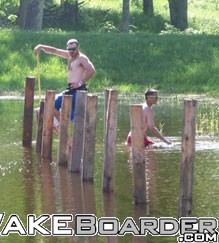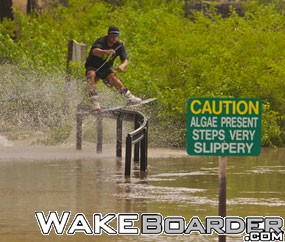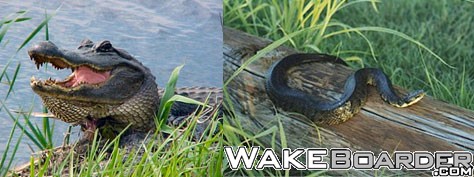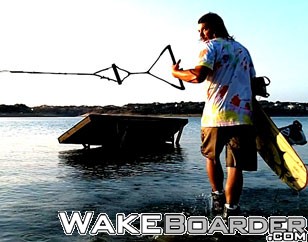Survival Guide for Winching
From an idea to an epic adventure, there is an extreme amount of preparation that goes into winching. Fortunately for you, I have been down the falls more than a few times and I have been asked to share the ups, downs, and undertows of an epic winching adventure.
The first and most important thing you're going to need is a winch. There are dozens of makes and models to choose from; ranging anywhere from a thousand to over ten thousand dollars depending on the size and accessories. You can even make your own if you feel mechanically inclined to do so.
From my experience, I would suggest purchasing one with at least a 6.5 horsepower motor so there is enough power to deep water start if need be. It takes a larger motor to do a deep water start verses a sliding start on shore. You will want to take this into consideration when locating and choosing spots that you and your crew will want to hit. If you test your winch and it is not fast enough, you can add rope to the spool to increase the diameter of the spool. This will increase your speed significantly. Wheels are also a huge necessity on a winch. Trust me, it sucks to carry a hundred pounds through the woods.

Photo by: Logan Farris
The second, and most difficult, step is to put together a crew. You will need at least three to five people, but any more than that and your riding time goes out the window and down the falls with your friends as they hog up all the riding time. Take note, it is also important to ride with people who are riding at a similar ability level to yours. Riders who don't quite have the skills are often hurt or complain because they don't want to hit the spots you and your more skilled friends may want to hit. It can also go the other way if you have members of your crew willing to take risks you are not. Without being cautious you could easily be injured or even worse, if things go wrong you or a friend could drown. Here is a brief breakdown of some skills the individuals on your crew will need. Remember your whole crew will likely want to be the rider at some point, so you all will need to be able to run the winch, as well as operate a camera to function as a crew.
Person #1 - The Rider
Person #2 - Winch Operator
You can winch with just two people, but for safety and documentation of your adventure you will for sure want at least a third.
Person #3 - Camera / Backup, just in case something goes haywire
Person #4 - Camera / Backup
Person #5 - Camera / Backup
The next step is for your crew to find a spot. Sometimes a spot can be as simple as a drainage ditch, or a rain puddle. Other times it may take an elaborate coordinated expedition to pull it off. There are many ways to find a great spot.
In my opinion, the best way to find a spot is to just look around you. There are always little puddles here and there after a good rain so keep your eyes peeled for a handrail near a low spot in the ground. The next time it rains, you may have an amazing spot!
My other favorite way to find a spot is with Google earth. Just jump online and cruise the squiggly lines of the rivers and creeks on the map and look for white lines. White lines indicate that the water is moving fast because of a drop in elevation. More or less you're looking for the white wash of waterfalls. Once you found your spot, go check it out. No matter how simple or complex your winching adventure is, it's always important to check out the spot before you hit it. Water depth, rocks, pipes, and other debris can be lurking under the water just waiting for you to fall and impale yourself on them.
That's the first golden rule of winching. ALWAYS check the water depth on both take off and landing. It's extremely sketchy to ollie in shallow water, almost sketchier than landing in it.
 
Photos by: Lana Merkley
Depending on the time of year and weather conditions, spots may fluctuate. Water levels can move up and down, rocks can move when pushed by flowing water, floods, or even people. The Fall and Spring are usually the prime times to take your winching adventure. The water may be a bit cooler, but most years the water levels are higher at these times and the cold deters some of the other dangers of winching. Snakes, spiders, alligators, and other potentially dangerous animals are usually hiding away in a warm hole somewhere waiting for the summer heat. So remember when you're planning your adventure to keep those things in mind as well. It's all fun and games until an alligator eats your friend.

Photos by: AP
Checking the water will also give you great chance to evaluate the situation at hand. You will need to know if it will be an easy or difficult swim to shore, if you fall. If there is a fast flowing current you may even want to tie a rope from one bank to the other as a safety line, just in case you or a friend is swept down stream.
How difficult is the walk, or swim back to the starting point. Remember! You have to carry the rope back every time. If you have to swim the rope back it's wise to find a shallow spot or island to put your board back on. This can be a daunting task after swimming and dragging the rope back out. Just trying to get to the starting point could easily exhaust you.
Which brings us to our second golden rule. ALWAYS wear a Coast Guard Approved life vest. I know a lot of the pros don't and its often shallow water, but you can drown in any amount of water. The impact protection you get from a thick vest is reason enough to wear one. You could even be swept down stream to a deeper area of a moving body of water. So just wear a vest, and a helmet is always a good idea as well.

Photo by: Logan Farris
While you are checking out the spot for safety, you will also want to be looking for good spots to film or shoot photos from. Anyone can stand and film from an easy angle, but you want your videos and photos to be top notch. Some things you can look for are signs, trees, stumps, bridges, or wildlife to put in the fore or background of your shots. A unique video is a great way to get your crew noticed.

Photo by: Ryan Taylor Visual
Once you've checked out the water and have determined that your spot is safe, you will need to find the perfect spot to place the winch. You will want to do this after you check the water for shallow spots. This may seem like such a big deal; however, you will need to have as high and direct line from start to finish to assure you get a good straight pull. If there is foliage in the way, you may need to cut or tie it away. Make sure you tie, strap, or stake down the winch so the winch doesn't roll away when the rider applies pressure to the rope. If it is not secure, you could lose your winch in the water.
I recommend keeping a winching survival kit with you on every adventure, including:
*A small hand saw, to cut away potential debris, or even to make a handle if needed
*Ratchet straps, to strap down the winch, or jib/rail
*A knife
*A hammer
*Steal stakes, to stake in the winch when there is nothing to strap to
*50' of rope, use for anything from tying back branches to a rescue line
*Screwdriver kit, because wakeboard bindings, and winch parts wiggle loose
*Gas, Winches don't take a lot of gas, but it's annoying when you run out
*First Aid kit, hopefully you won't need it, but you more than likely will
Now it's finally time to have some fun! Pull out the line and session your new spot until the water dries up, or at least until the cops run you off...
It may sound funny, but more often than not, people call the police because they just don't have any clue what you're doing there and it's just crazy for them to even think about jumping off a waterfall. Most people who call the police are just concerned for your safety, so do not call them a F%&@ F%@$ for ruining your good time. Instead, try to reason with whoever confronts you, try showing them a video on your phone or show them a magazine of what winching is about. Do anything to spark their interest in wakeboarding. Many times, if you'e nice, you can keep riding at that spot and maybe even make a new friend or fan, but one thing is for sure, you NEVER get to keep riding when you have an attitude with the police.
Which brings me to the third and final golden rule of winching, DO NOT F#@k with the police. Most great winch spots are controlled, either by the Department of Natural Resources, the Army Core of Engineers, or even the Department of Homeland Security. Water, and the controlled flow of it, is considered to be one of our nation's most precious resources, so try and think of the big picture when looking for spots. If you get ran off, don't get mad, just find a better spot. There are thousands of spots out there, and it's not worth going to jail for!!!

Photo: AP
Now you know the ins and outs of getting your first winching adventure going. From preparation and planning, to execution and documentation. Good luck and be safe on your winching adventure.
Send your epic winching adventure videos into Wakeboarder.com! We would love to see them.
by: Jade Whirley
|
|

